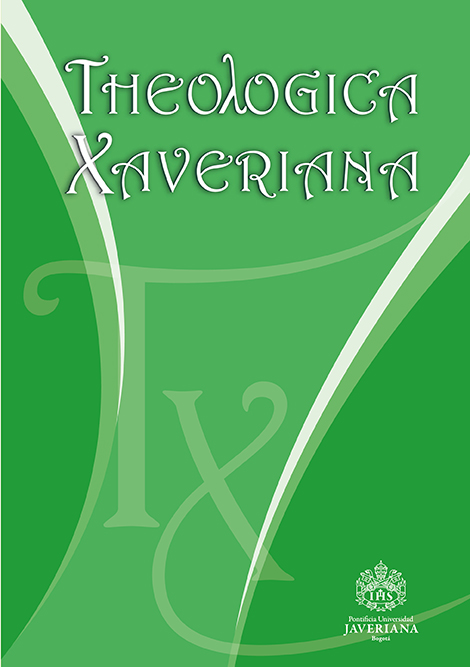Resumen
Este artículo busca demostrar, a partir de la estrategia comunicativa-pragmática, que Mc 16, 1-8 es el final eficaz que el autor propone a todo lector. Las diversas hipótesis generadas por Mc 16, 1-8, –texto que sigue siendo una crux interpretum, tanto para exégetas como para hermeneutas– son el punto de partida. Lo dicho está evidenciado, desde muy temprano, en las correcciones de las que ha sido víctima: mutilaciones, intentos de armonización y ampliaciones que pretenden llevar a feliz término el Evangelio de Jesús Mesías Hijo de Dios, un Buen Anuncio con ἀρχή (Mc 1,1), pero sin un final.
La estrategia del autor del Evangelio según Marcos es dejar el final de su obra abierto, a fin de empujar al lector en el fatigoso paso de espectador a discípulo. A partir de lo expuesto, las preguntas que se formulan para la investigación van direccionadas (como es propio de la aproximación comunicativa-pragmática) a delinear los efectos que busca lograr Marcos con su final en los diferentes tipos de lectores; esto, teniendo presente que cuando un autor pone en marcha una obra escrita lo hace mediante estrategias que hagan factible, comprensible y eficaz el mensaje que busca comunicar. Cuando se trata del final de la obra, el momento de
clímax, es fundamental preguntarse y profundizar en la potencia performativa de los motivos semánticos que lo cohesionan. Por último, se presta atención a cómo se verifica en cada uno de los enunciados que la comunicación vaya direccionada a alcanzar su “final feliz”. Es precisamente en este punto donde se argumenta que Marcos presenta como resultado de su estrategia un final tan paradójico como paradigmático.
Beauchamp, Paul. “Teología bíblica”. En Iniciación a la práctica de la teología. I: Introducción, dirigido por Bernard Lauret, François Refoulé, 189-237. Madrid: Cristiandad, 1984.
Bernabé, Carmen. “Duelo y género en los relatos de la visita a la tumba”. En Reimaginando los orígenes del cristianismo, editado por C. Bernabé y C. Gil, 307-352. Estella (Navarra): Verbo Divino, 2008.
Bertram, Georg. “θάμβος (asombrarse, maravillarse)”. En Grande Lessico del Nuovo Testamento, dirigido por Gerhard Kittel y Gerhard Friedrich IV, 147-156. Brecia: Paideia, 1968.
Boomershine, Thomas, y Gilbert Bartholomew. “The Narrative Technique of Mark 16:8”. Journal of Biblical Literature 100 (1981): 213-223.
Cadwallader, Alan H. “The Hermeneutical Potential of the Multiple Endings of Mark’s Gospel”. Colloquium 43 (2011): 129-146.
Casas, Juan Alberto. Ciegos y sordos. Clave hermenéutica del discipulado pospascual en el Evangelio según Marcos. Bogotá: Editorial Javeriana, 2018.
Collins, Adela. Mark. A Commentary. Minneapolis (MN): Augsburg Fortress, 2007.
Corallo, Ana Maria. Atelier della Bibbia. Dal tessuto della Scrittura al vestito della Parola. Bologna: Edizioni Dehoniane, 2013.
Croy, N. Clayton. The Mutilation of Mark’s Gospel. Nashville (TN): Abingdon Press, 2003.
Culpepper, Aland. Mark. Macon (GA): Smyth & Helwys, 2007.
Enslin, Morton. “εφοβου̂ντο γάρ, Mark 16:8”. Journal of Biblical Literature 46 (1927): 62-68.
Focant, Camile. Il Vangelo secondo Marco. Assisi: Cittadella Editrice, 2015.
Grilli, Massimo. “Paradosso” e “mistero”. Il Vangelo di Marco. Bologna: Edizioni Dehoniane, 2012.
Grilli, Massimo; Mauricio Guidi; y Elzbieta Obara. Comunicación y pragmática en la exégesis bíblica. Estella (Navarra): Verbo Divino, 2018.
Hurtado, Larry W. “The Women, the Tomb, and the Climax of Mark”. En A Wandering Galilean: Essays in Honour of Seán Freyne, editado por Zuleika Rodgers, Margaret Daly-Denton, y Anne Fitzpatrick-McKinley, 427-450. Leiden: Brill, 2009.
Iverson, Kelly. “A Further Word on Final Γάρ (Mark 16:8)”. The Catholic Biblical Quarterly 68 (2006): 79-80.
Lane, William. The Gospel of Mark. Grand Rapids (MI): William B. Eerdmans Publishing Company, 1974.
Légasse, Simon. Marco. Roma: Borla, 2000.
Lincoln, Andrew. “The Promise and the Failure: Mark 16:7, 8”. Journal of Biblical Literature 108 (1989): 283-300.
Manicardi, Ermenegildo. Il cammino di Gesù nel Vangelo di Marco. Roma: Editrice Pontificio Istituto Biblico, 2003.
Marcus, Joel. El Evangelio según Marcos (Mc 8-16). Salamanca: Sígueme, 2010.
Miller, Susan. “‘They Said Nothing to Anyone’: The Fear and Silence of the Women at the Empty Tomb (Mk 16.1-8)”. Feminist Theology 13 (2004): 77-90.
Moloney, Francis. The Gospel of Mark: A Commentary. Ada (MI): Baker Academic, 2012.
Obara, Elzbieta. Le strategie di Dio: dinamiche comunicative nei discorsi divini del Trito-Isaia. Roma: Pontificio Instituto Bíblico, 2010.
Oepkel, Albrecht. “ἔκστασις (estupor, consternación)”. En Grande Lessico del Nuovo Testamento, dirigido por Gerhard Kittel y Gerhard Friedrich III, 323-349. Brecia: Paideia, 1967.
Oliver, Kevin Robert. “The Lost Ending of the Gospel According to Mark: A Criticism and a Reconstruction”. Journal of Biblical Literature 45/1-2 (1926): 81-103.
Pasolini, Roberto. Fallire e non mancare il bersaglio. Paradosso del Regno e strategie comunicative nel Vangelo di Marco. Bologna: Edizioni Dehoniane, 2017.
Pesch, Rudolf. Il Vangelo di Marco. Parte seconda. Testo greco e traduzione. Commento ai capp. 8 ,2 7—1 6,20. Brescia: Paideia, 1982.
Schneider, G. “εἰσέρχομαι (entrar, penetrar, ir hacia el interior de un lugar)”. En Grande Lessico del Nuovo Testamento, dirigido por Gerhard Kittel y Gerhard Friedrich III, 940-947. Brecia: Paideia, 1967.
Standaert, Benoît. Marco. Vangelo di una notte, vangelo per la vita. Commentario Mc 11,1–16,20. Bologna: Edizioni Dehoniane, 2011.
Taylor, Vicent. Evangelio según San Marcos. Madrid: Cristiandad, 1979.
Vignolo, Roberto. “Una finale reticente: interpretazione narrativa di Mc 16,8”. Rivista Biblica Italiana XXXVIII (1990): 129-189.
Weren, Wim. Métodos de exégesis de los evangelios. Estella (Navarra): Verbo Divino, 2003.
Williams, Guy J. “Narrative Space, Angelic Revelation, and the End of Mark’s Gospel”. Journal for the Study of the New Testament, JSNT 35 (2013): 263-284.
Zerwick, Max. El griego del Nuevo Testamento. Traducido por Alfonso de la Fuente Adánez. Estella (Navarra): Verbo Divino, 1997.

Esta obra está bajo una licencia internacional Creative Commons Atribución 4.0.


